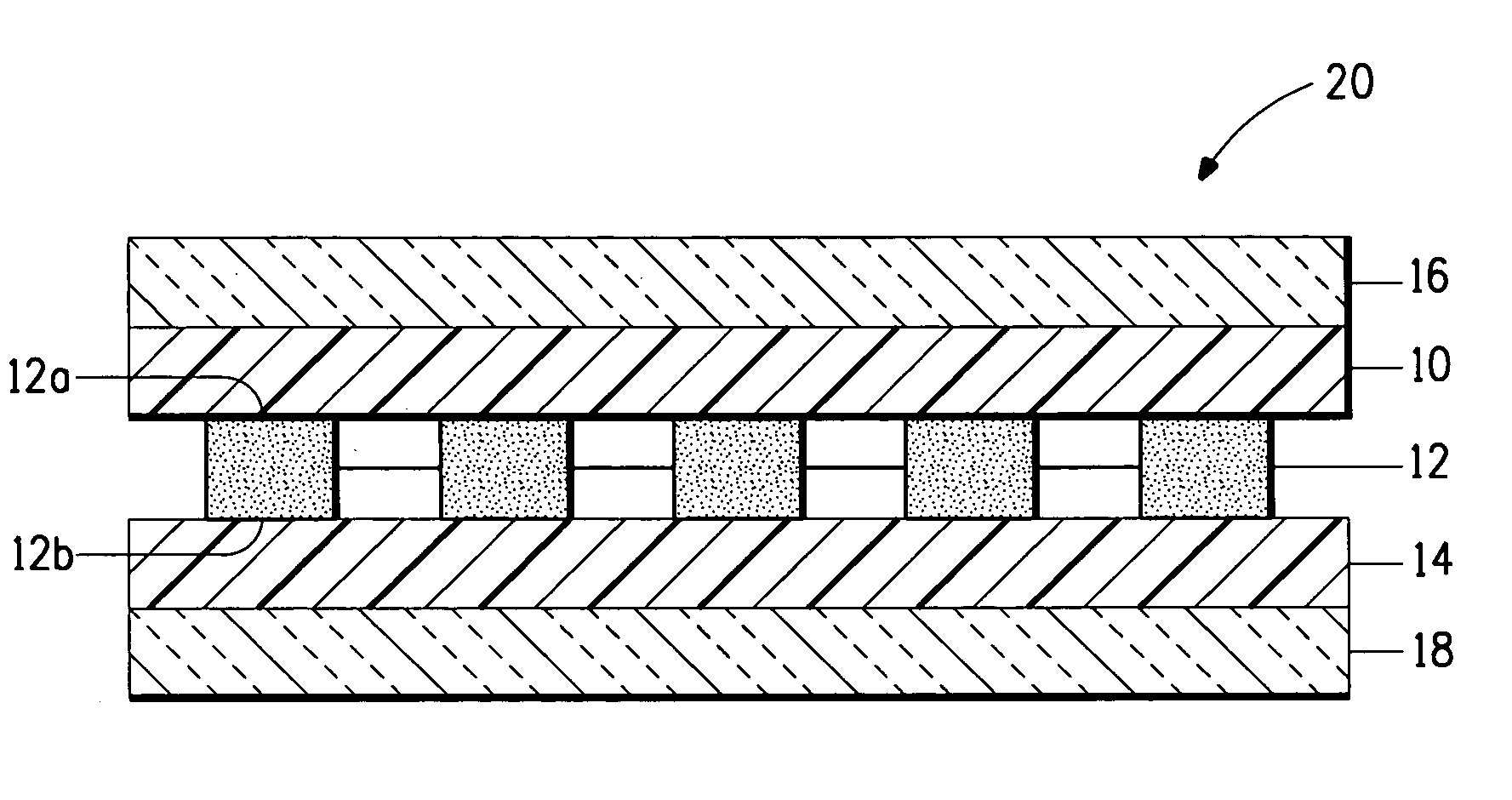Solar cell encapsulant layers with enhanced stability and adhesion
a technology of encapsulant layers and solar cells, applied in the direction of generators/motors, pv power plants, light radiation electric generators, etc., can solve the problems of low creep resistance during the lamination process and end-use, low weathering and light stability, and complicating the sheet production and ensuing lamination processes
- Summary
- Abstract
- Description
- Claims
- Application Information
AI Technical Summary
Benefits of technology
Problems solved by technology
Method used
Image
Examples
examples
[0098]The following Examples and Comparative Examples are intended to be illustrative of the present invention, and are not intended in any way to limit the scope of the present invention. The solar cell interconnections are omitted from the examples below to clarify the structures, but any common art solar cell interconnections may be utilized within the present invention.
Methods
[0099]The following methods are used in the Examples and Comparative Examples presented hereafter.
I. Compressive Shear Strength Test:
[0100]Compressive Shear Strength was determined through the method disclosed within U.S. Pat. No. 6,599,630, the entire disclosure of which is enclosed herein by reference. Essentially, the compressive shear strength of a laminate was determined using the method detailed herein. Six 1 inch by 1 inch (25 mm by 25 mm) chips are sawed from the laminate. The chips are conditioned in a room controlled at a temperature of 23° C.±2° C. and a relative humidity of 50%±1% for one hour ...
examples 1-21
[0112]The ionomer sheets comprising one of the ionomers listed in Table 1 were produced by extrusion cast. Examples 1-21 were glass laminates of a layer of annealed float glass sheet (6 inch by 12 inch (152 mm by 305 mm) by 2.5 mm thick) and a layer of one of the ionomer sheets listed in Table 1 (6 inch by 12 inch by 30 mil (0.76 mm) thick), wherein the tin sides of the glass layers were in contact with the sheets. These glass laminates were then subjected to 180-degree peel strength adhesion testing using an INSTRUMENTORS, Inc., Model SP-102B-3M90 SLIP / PEEL Tester at a rate of 1 inch per minute. The results are noted below within Table 1, wherein “ND” denotes “not determined”.
TABLE 1Peel AdhesionNotAfter Conditioning AtExampleConditioned23% RH50%RHMaterial(lbs / in)(lbs / in.)(lbs / in)(lbs / in)1Ionomer 11.46.25.33.22Ionomer 2ND4.13.03.63Ionomer 3ND4.74.61.84Ionomer 4ND4.83.73.15Ionomer 51.84.23.81.96Ionomer 5ND8.43.73.27Ionomer 6ND8.78.44.98Ionomer 7ND12.27.15.89Ionomer 8ND13.310.9 5.510...
examples 22-42
[0113]Examples 22-42 were glass laminates similar to those of the Examples 1-21 except that the air sides of the glass sheets were in contact with the ionomer sheets. The laminates were also subject to 180-degree peel strength adhesion testing using an INSTRUMENTORS, Inc., Model SP-102B-3M90 SLIP / PEEL Tester at a rate of 1 inch per minute. The results are noted below within Table 2, wherein “ND” denotes “not determined”.
TABLE 2Peel AdhesionAfter Conditioning At23% RH50% RHExampleMaterial(lbs / in)(lbs / in)(lbs / in)22Ionomer 14.94.31.823Ionomer 22.31.82.224Ionomer 32.43.60.925Ionomer 43.62.41.326Ionomer 52.72.01.227Ionomer 58.02.92.128Ionomer 65.75.13.029Ionomer 79.04.24.030Ionomer 87.36.43.331Ionomer 911.08.82.932Ionomer 1014.17.95.533Ionomer 112.0ND0.434Ionomer 122.2ND0.635Ionomer 133.81.62.736Ionomer 146.04.91.937Ionomer 157.9ND2.138Ionomer 166.210.7 6.239Ionomer 172.76.38.040Ionomer 1815.26.48.241Ionomer 195.45.66.242Ionomer 2012.2ND6.3
PUM
| Property | Measurement | Unit |
|---|---|---|
| total thickness | aaaaa | aaaaa |
| MI | aaaaa | aaaaa |
| MI | aaaaa | aaaaa |
Abstract
Description
Claims
Application Information
 Login to View More
Login to View More - R&D
- Intellectual Property
- Life Sciences
- Materials
- Tech Scout
- Unparalleled Data Quality
- Higher Quality Content
- 60% Fewer Hallucinations
Browse by: Latest US Patents, China's latest patents, Technical Efficacy Thesaurus, Application Domain, Technology Topic, Popular Technical Reports.
© 2025 PatSnap. All rights reserved.Legal|Privacy policy|Modern Slavery Act Transparency Statement|Sitemap|About US| Contact US: help@patsnap.com


